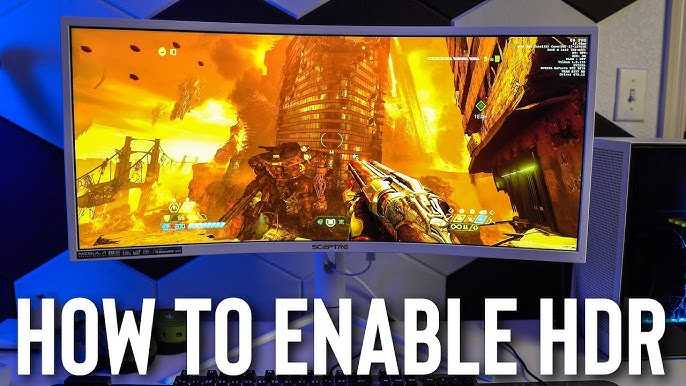To enable HDR on your curved gaming monitor, simply access your display settings or video card control panel, turn on HDR mode, and make sure your content supports HDR. It’s a quick setup that can dramatically enhance your gaming visuals with vibrant colors and better contrast.
In short, enabling HDR involves activating the feature through your monitor’s menu or your graphics card settings, ensuring your content is HDR-compatible, and adjusting the necessary settings for optimal performance. Once set up, you’ll experience richer images and more immersive gameplay on your curved display.
Getting the most out of your curved gaming monitor isn’t just about the hardware; it’s about tweaking the right settings to unlock stunning visuals. Many gamers overlook the HDR option, not realizing it can elevate their gaming experience with brighter highlights and deeper blacks. In this guide, we’ll walk you through the simple steps to enable HDR on your curved gaming monitor, helping you enjoy your games in all their vivid glory. Whether you’re a casual gamer or a competitive player, turning on HDR can make everything look more lifelike and exciting without the need for new equipment.
How to Enable HDR on Curved Gaming Monitor
Understanding HDR and Its Benefits for Gaming
High Dynamic Range (HDR) enhances your gaming experience by providing brighter highlights, deeper shadows, and more vibrant colors. It makes game visuals look more realistic and immersive. If your gaming monitor is curved and supports HDR, enabling this feature can significantly improve the visual quality of your games.
Check if Your Curved Gaming Monitor Supports HDR
Before proceeding, confirm that your monitor supports HDR technology. Look for specifications mentioning HDR10 or Dolby Vision support in your monitor’s user manual or product webpage. Not all curved monitors come with HDR capabilities, so verifying this is essential.
Gather Necessary Hardware and Software
Ensure your PC or gaming console has up-to-date hardware capable of processing HDR content. This includes:
- Graphics card that supports HDR
- Latest graphics drivers installed
- HDMI or DisplayPort cable capable of transmitting HDR signals
Updating your system software and drivers is crucial for optimal HDR performance and compatibility.
Connect Your Monitor Correctly
Use high-quality HDMI 2.0 or DisplayPort 1.4 cables to connect your device to the monitor. These cables are designed to transmit HDR signals effectively. Once connected, ensure that the cables are securely plugged in to avoid signal issues.
Enable HDR in Windows Settings
On Windows computers, follow these steps:
- Right-click the desktop and select Display Settings.
- Scroll down and click on Windows HD Color Settings.
- Locate Use HDR and toggle it to On.
- Adjust the HDR and advanced color settings as needed to optimize visual quality.
Verify that the monitor indicates HDR is active, usually with an icon or notification.
Enable HDR on Your Gaming Console
For gaming consoles like Xbox or PlayStation:
- Navigate to Settings.
- Go to Display & Sound.
- Select Video Output.
- Turn on Enable HDCP and select HDR options.
- Ensure the console is set to output in HDR mode for supported games.
Adjust these settings based on specific console models and firmware versions.
Configure Your Game Settings for HDR
Some games require manual activation of HDR within their settings menus. Check each game’s display or video settings for HDR options. Enable HDR mode to see the full spectrum of colors and brightness levels.
Adjust Brightness and Contrast Settings
Fine-tune your monitor’s brightness and contrast for optimal HDR viewing. Many curved monitors feature on-screen display (OSD) controls:
- Set the brightness to suit your environment.
- Adjust contrast for better dynamic range.
- Use built-in HDR calibration tools if available.
Proper adjustments make HDR content look more balanced and realistic.
Optimize Your Monitor’s HDR Settings
Consult your monitor’s user manual for specific HDR configuration options. Some monitors have dedicated HDR modes or picture presets:
- Enable HDR mode if available.
- Choose picture presets like Game HDR or Vivid.
- Disable any unnecessary image processing features that could interfere with HDR quality.
Properly configuring these settings ensures the best visual output.
Test HDR Functionality
Verify HDR is working correctly:
- Play a supported HDR game or app.
- Look for indicators such as HDR icons or notifications.
- Use HDR calibration videos or tools online to check color and brightness accuracy.
If HDR does not activate, double-check all connections and settings.
Common Troubleshooting Tips
Having issues enabling HDR? Try these actions:
- Use the latest drivers and system updates.
- Switch to a different HDMI or DisplayPort cable.
- Restart your PC or gaming console after changing settings.
- Ensure your monitor firmware is up to date.
- Disable and re-enable HDR in settings to refresh the connection.
Persistent problems may require consulting the manufacturer’s support resources.
Related Topics and Additional Tips
Consider exploring:
Choosing the Right Curved Gaming Monitor for HDR
Look for features such as high peak brightness, wide color gamut, and local dimming capabilities. These elements significantly affect HDR quality.
Understanding HDR Standards
Familiarize yourself with HDR10, Dolby Vision, and HDR gaming-specific standards to maximize compatibility. Each has different requirements and supported content.
Adjusting Your Gaming Environment
Create an ideal setting by reducing ambient light and using appropriate seating distances. Proper environment management enhances HDR viewing experiences.
Maintaining Your Monitor for Optimal Performance
Regularly clean your screen and keep firmware updated. Proper maintenance keeps your HDR performance at its best.
Final Tips for a Smooth HDR Experience
Ensure all hardware components are compatible and properly configured. Use high-quality cables and settings customized to your environment. Testing with various content helps you find the perfect balance for consistent HDR gaming.
Alienware AW3423DWF OLED Gaming Monitor HDR settings
Frequently Asked Questions
What steps should I follow to activate HDR on my curved gaming monitor?
To enable HDR on your curved gaming monitor, first ensure your graphics card supports HDR and that your operating system is updated. Next, go to your display settings and locate the HDR option. Turn it on, then access your monitor’s on-screen menu to confirm that HDR mode is enabled. Adjust any necessary picture settings to optimize HDR performance for your gaming sessions.
How can I verify that HDR is properly enabled on my monitor after activation?
After turning on HDR, check if your games and applications display HDR content correctly. You can also use built-in diagnostic tools or display test images labeled as HDR to confirm. In Windows, navigate to display settings and see if the system indicates that HDR is active. On your monitor, look for any indicator or setting that confirms HDR mode is engaged.
What common issues might prevent HDR from activating on a curved gaming display?
Common issues include outdated graphics drivers, incompatible cables, or incorrect display settings. Make sure you use a high-quality HDMI 2.0 or DisplayPort 1.4 cable capable of transmitting HDR signals. Ensure your GPU drivers are current, and double-check that your monitor’s firmware is up to date. Also, verify that your system recognizes your monitor as supporting HDR and that the feature is enabled in both system and monitor menus.
Are there specific settings within my game that I need to adjust to enjoy HDR content fully?
Yes, many games have dedicated HDR settings that need to be enabled. Access the game’s video or graphics options and look for HDR or High Dynamic Range settings. Turn these on, and adjust brightness, contrast, and color options if available to match your monitor’s capabilities. Properly configuring in-game HDR ensures the best visual experience during gameplay.
How do I ensure my monitor’s firmware is compatible with HDR features?
Check your monitor manufacturer’s website or user manual to find firmware update instructions. Download the latest firmware and follow the provided steps for installation. Keeping your monitor’s firmware up to date helps in resolving compatibility issues and improves HDR support, ensuring that your gaming experience remains smooth and visually rich.
Final Thoughts
To enable HDR on a curved gaming monitor, start by accessing the display settings through your graphics card control panel or monitor menu. Adjust the picture mode to HDR or similar options available. Ensure your monitor is connected with an HDMI 2.0 or DisplayPort 1.4 cable, as these support HDR signals.
Finally, enable HDR in your operating system settings. On Windows, go to Display Settings and toggle HDR on. How to enable hdr on curved gaming monitor is straightforward with these steps, ensuring a vibrant gaming experience.

With experience in IT support and consumer technology, I focus on step-by-step tutorials and troubleshooting tips. I enjoy making complex tech problems easy to solve.





